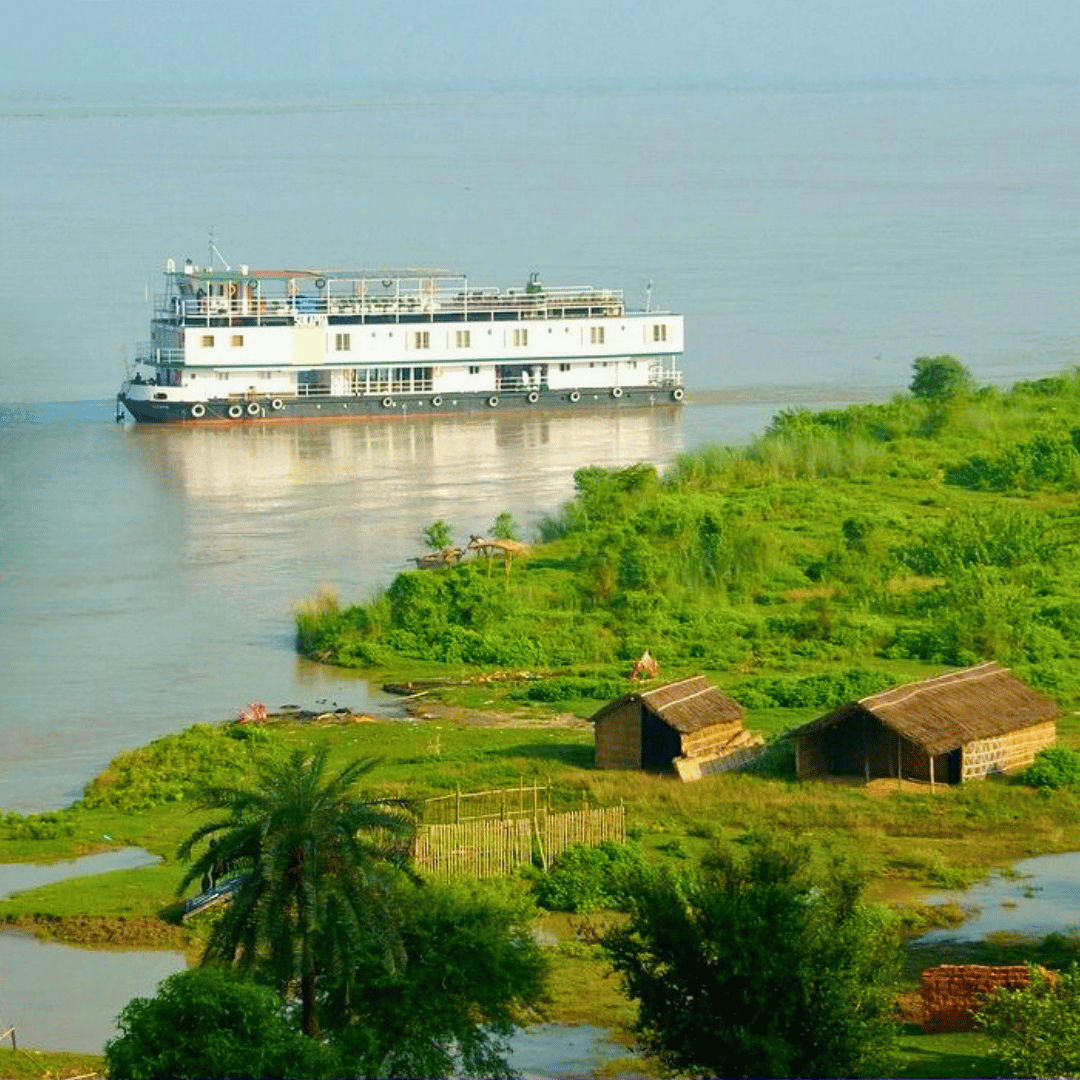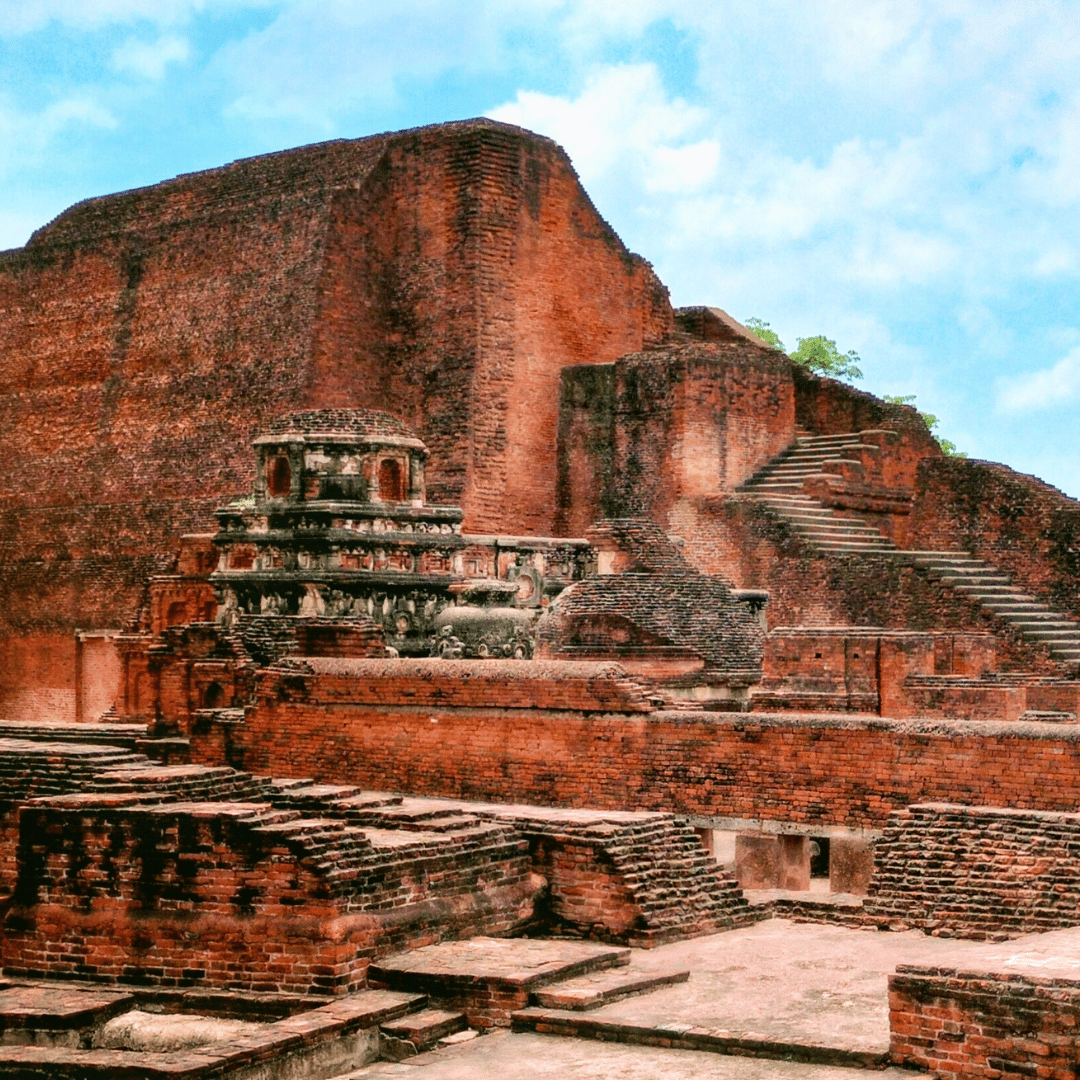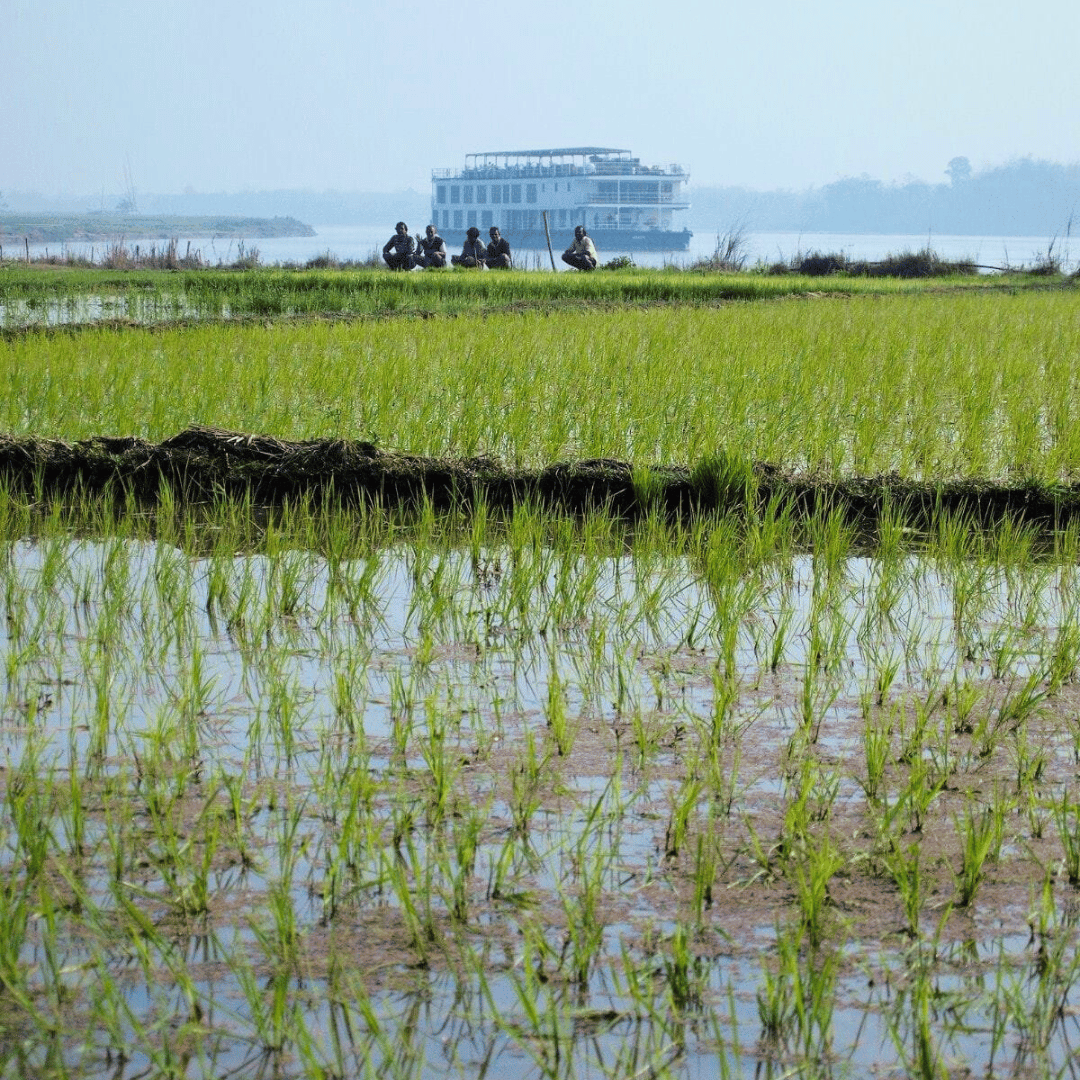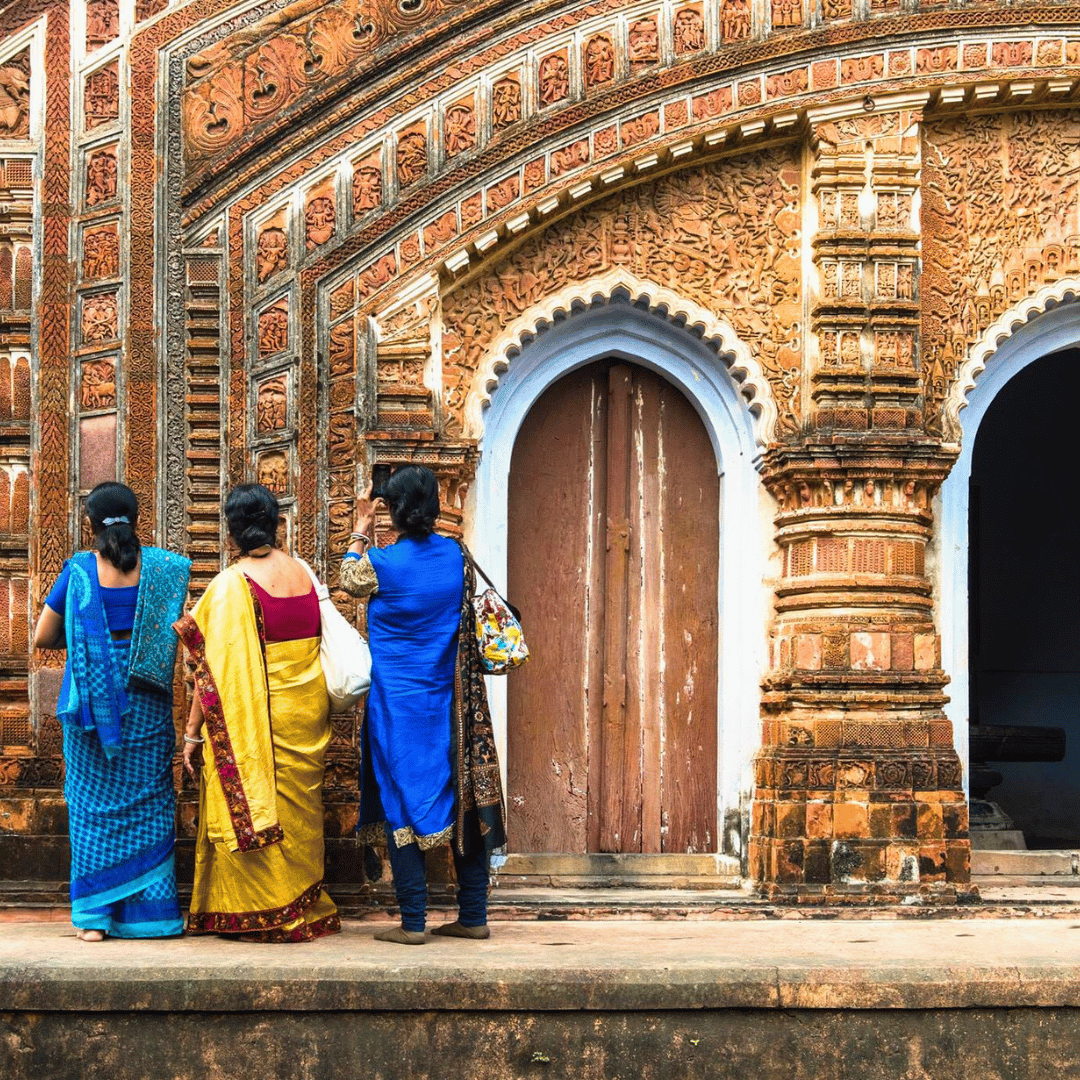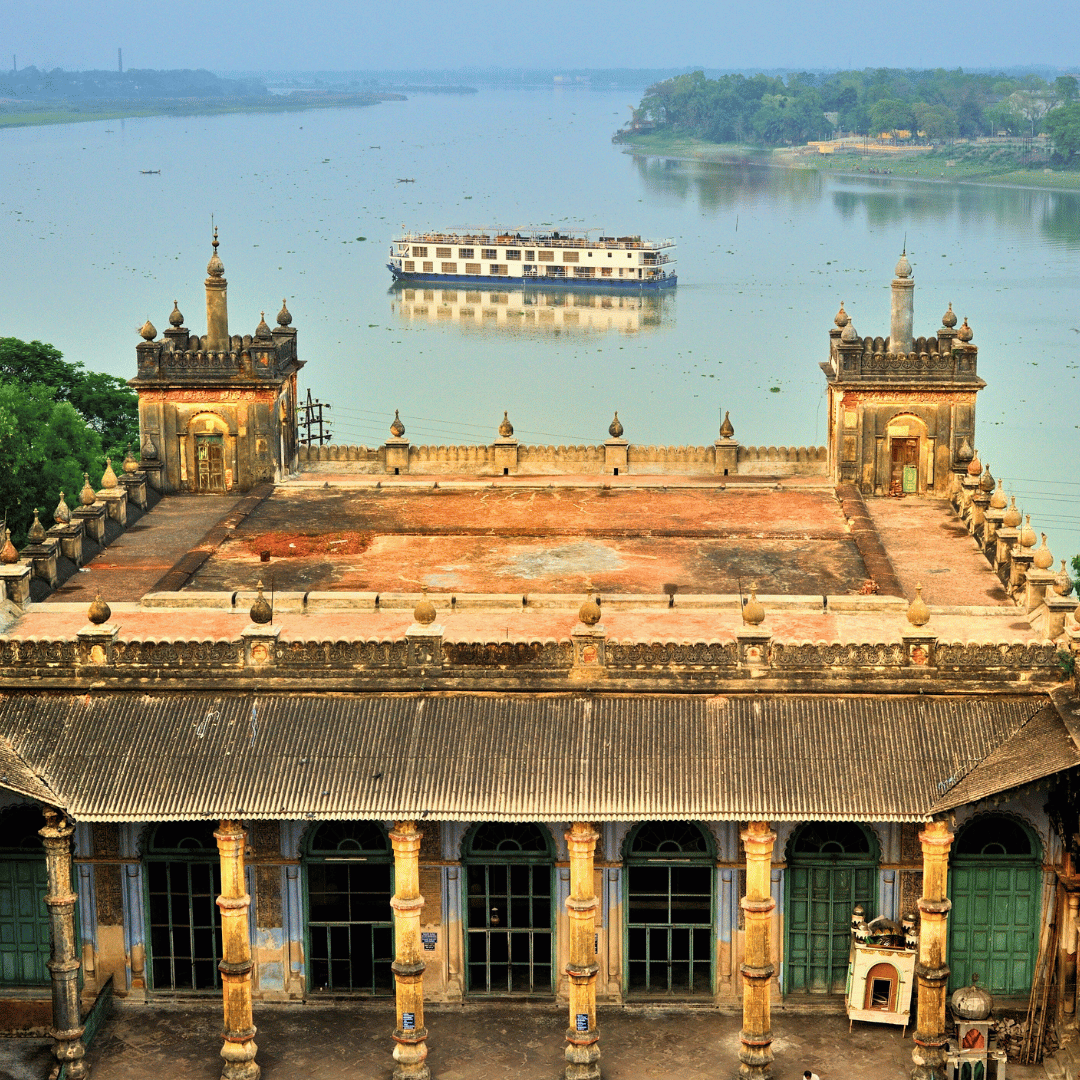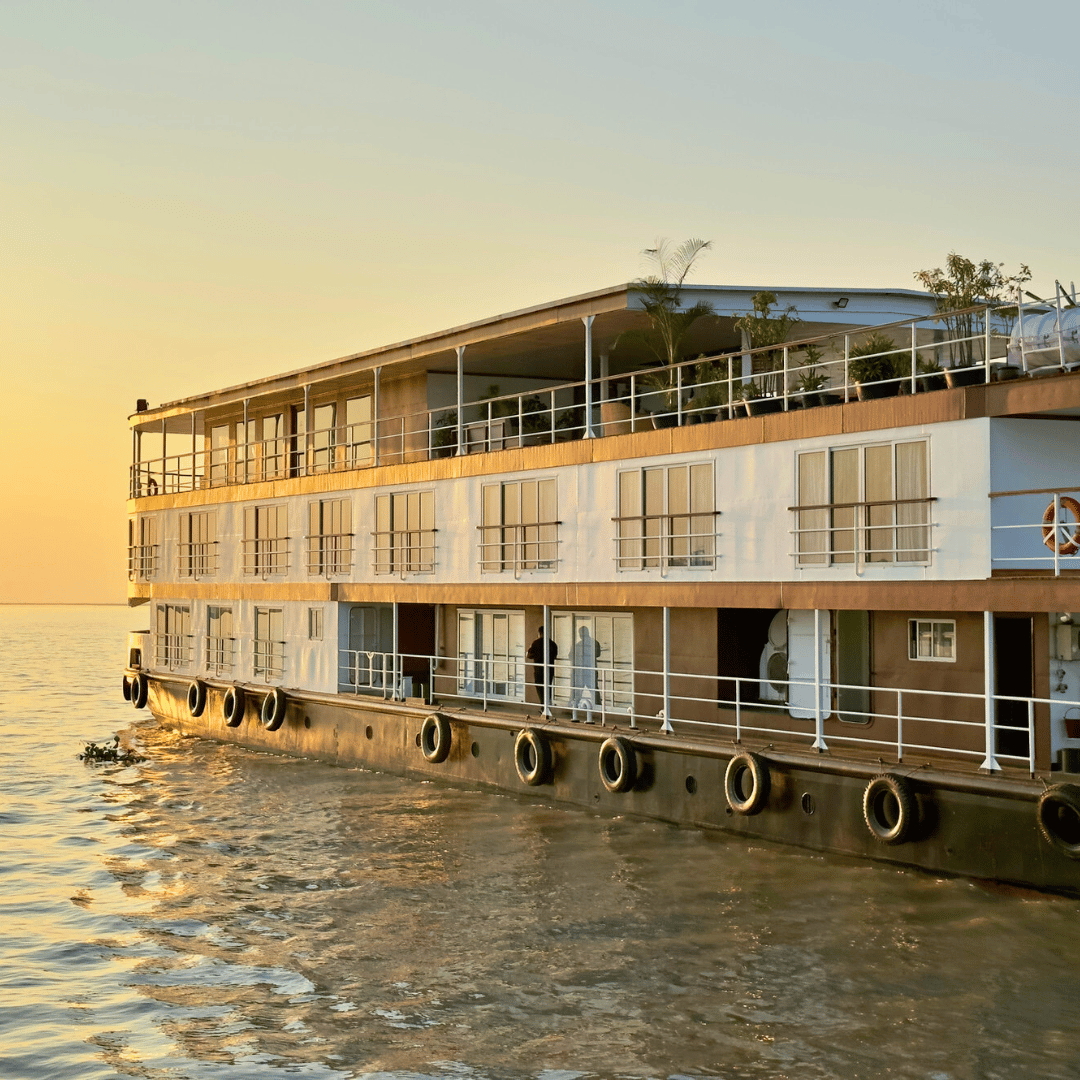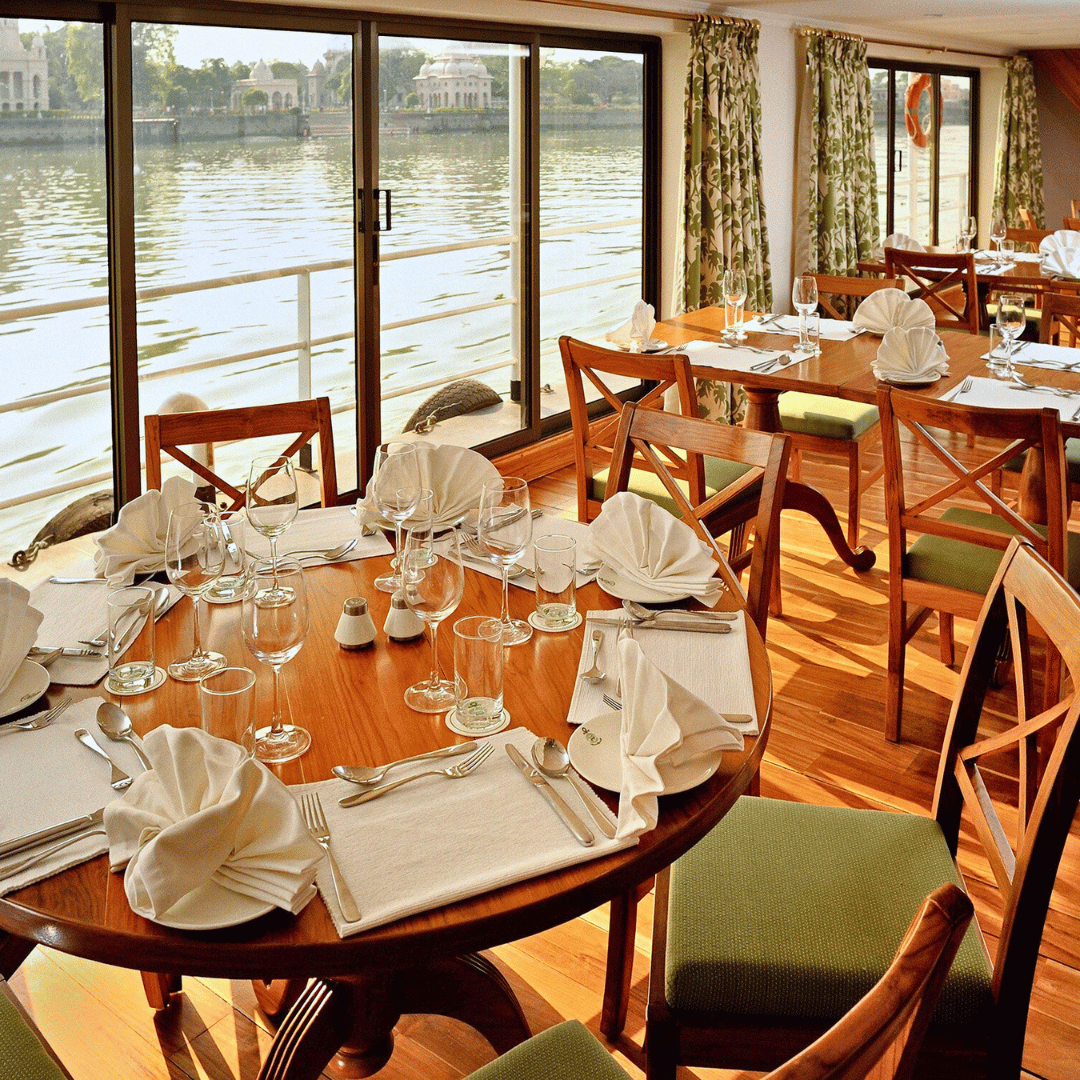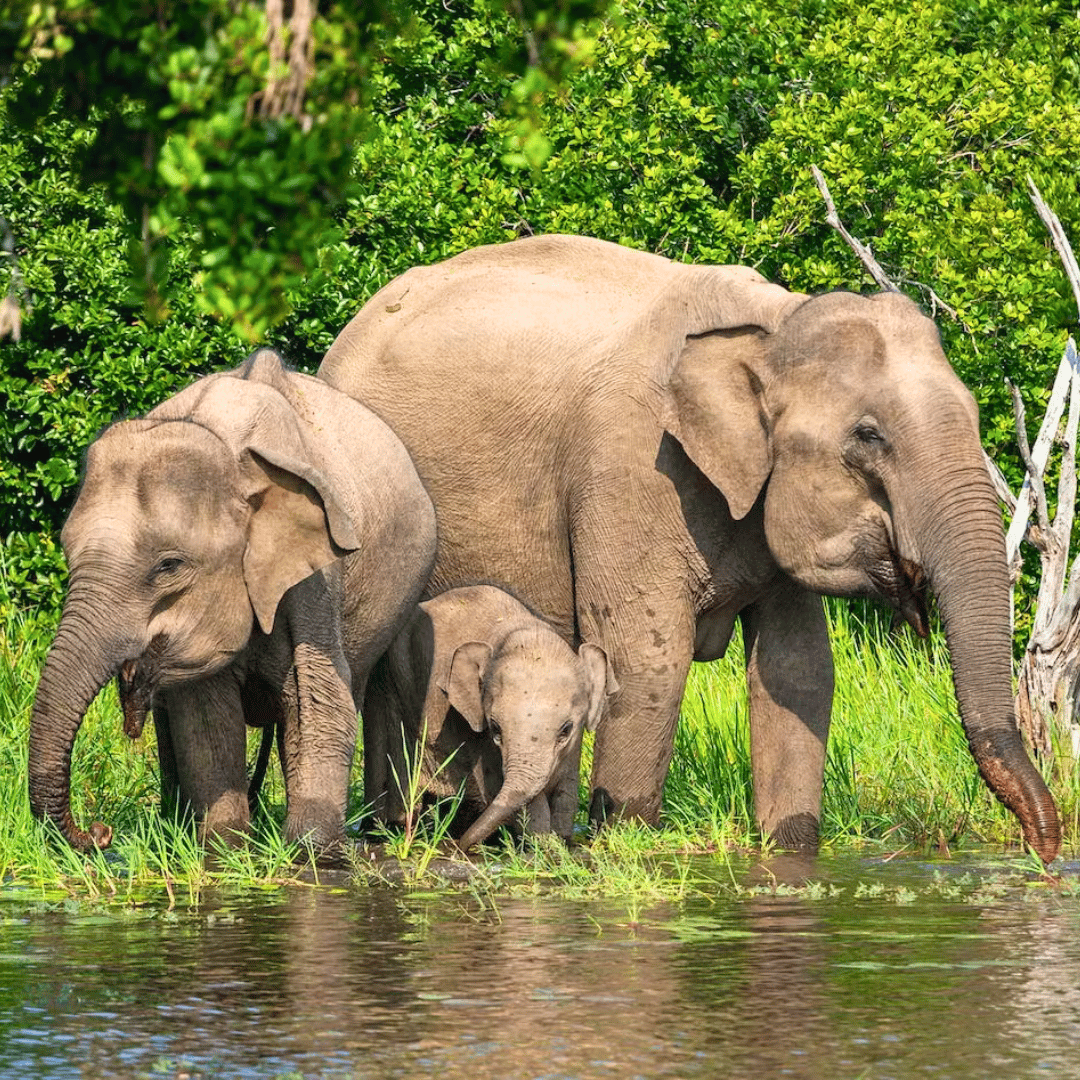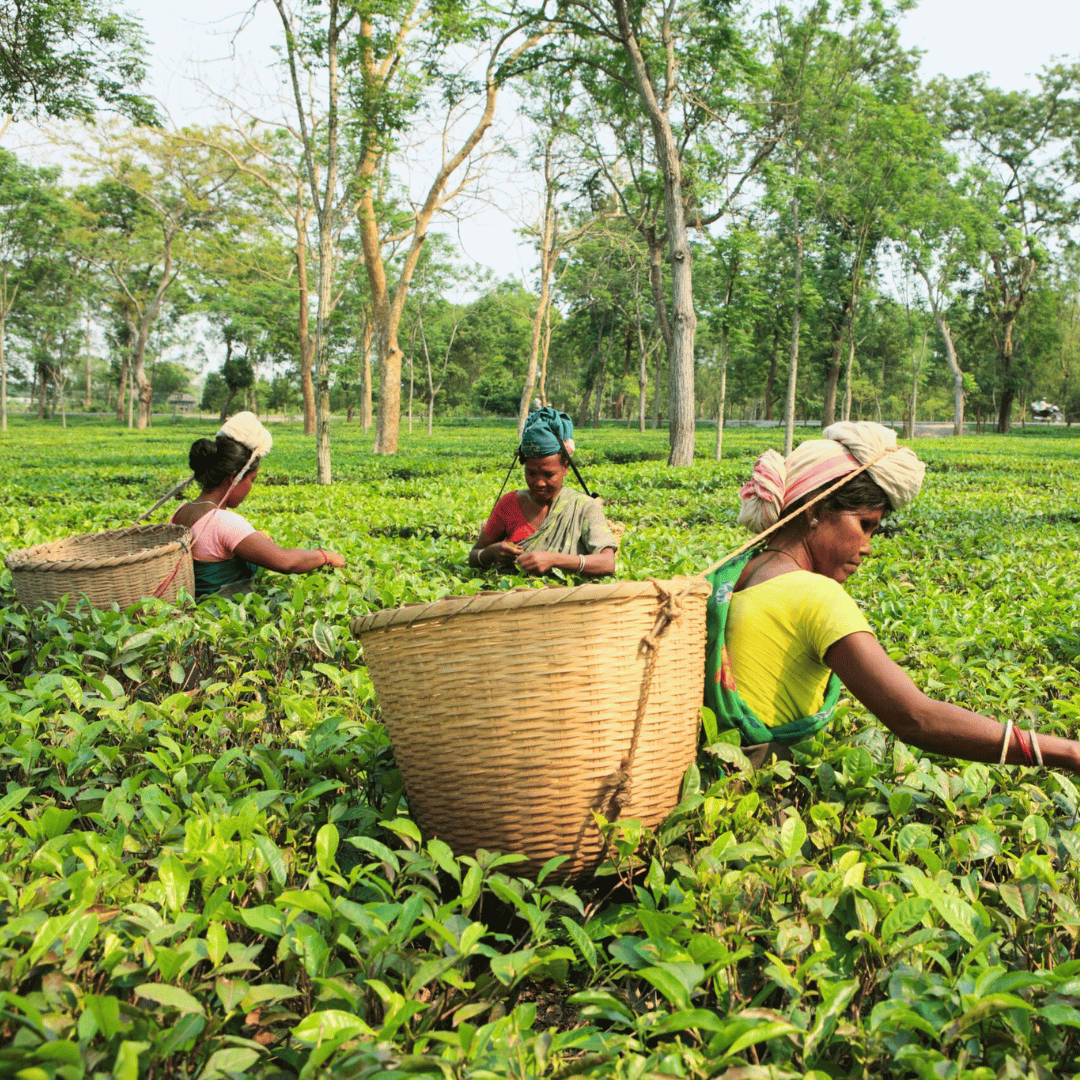Ganges River Cruise Itinerary
-
Begin your journey with a 4-hour (approximately) train ride from Kolkata to Farakka, followed by a short road transfer to the ship. Guests who are joining the cruise independently at Farakka can board the ship from midday onwards.
Today also includes an excursion by road to the historic town of Gaur. Once one of India’s most important cities, Gaur was a flourishing hub under Hindu rule in the 12th century, and later became the Muslim capital of Eastern India from the 14th to the 16th centuries. The town is now quiet and largely deserted, but its architectural remains, including mosques, palaces, and gateways, provide a fascinating glimpse into this rich and diverse history.
After exploring Gaur, the journey continues through Malda, also known as English Bazar, a town with its own colonial legacy. From there, travel to Pandua to visit the remarkable 14th-century Adina Mosque, an impressive example of Islamic architecture. The mosque, once a grand place of worship, reflects the area’s historical significance during the medieval period. Afterward, return to Farakka where your ship will be waiting, having passed through the lock at the Farakka Barrage. This experience offers a rich cultural and historical introduction to West Bengal, with each stop bringing a new chapter of India’s past to life.
-
This morning, you’ll depart Farakka and set sail into the expansive Ganges River, just above the vast Farakka Barrage. The river here takes on the characteristics of a broad, almost sea-like expanse, offering a unique experience as you navigate upstream. You’ll sail for much of the morning, taking in the changing landscape and the peaceful flow of the river.
By afternoon, you’ll arrive at Rajmahal, a place rarely mentioned in guidebooks but brimming with historical significance and a distinct atmosphere. Once known as Akbarnagar, this town was founded by the great Mughal Emperor Akbar as his eastern capital. It was here that Shah Jehan, the builder of the Taj Mahal, spent much of his youth. Despite its modest appearance today, Rajmahal holds a wealth of history in its scattered ruins.
As you explore, you’ll find remnants of palaces, forts, and mosques, all partially engulfed by the surrounding vegetation. These structures offer a glimpse into the grandeur of Akbar’s empire and the vibrant past of this once-thriving city. After a leisurely exploration, the cruise continues, and you’ll sail onwards, heading towards Manihari Ghat, a peaceful location along the Ganges, to anchor for the evening.
-
This morning, the cruise continues upstream, with the Ganges River gradually widening as you pass the confluence with the Kosi River, which flows down from Nepal. The scenery becomes even more captivating as the river takes on a more tranquil and expansive feel, offering a perfect opportunity to sit back and enjoy the surroundings.
Your first stop is at Bateshwar, an idyllic location that is home to 6th-century Hindu carvings. These intricate carvings, set against the backdrop of lush greenery, offer a fascinating glimpse into India’s religious and artistic history. The area also holds the ruins of an 8th-century Buddhist stupa and monastery at Vikramshila, once an important centre of Buddhist learning. These ancient structures evoke a sense of serenity and antiquity, providing a peaceful space to reflect on the spiritual and cultural heritage of the region.
After exploring Bateshwar and Vikramshila, the cruise continues towards Kehilgaon or Colganj, where the ship awaits. Along the way, you’ll pass through a stretch of the river that feels almost timeless, with villages and landscapes that remain unchanged for centuries.
As you sail on, you’ll approach an island shrine, a sacred site that contains both Buddhist and Hindu cave temples. This unique location was once the centre of the notorious Thug sect, a group whose history is marked by secrecy and violence. Today, the site remains a place of reflection, with its cave temples offering a quiet yet poignant reminder of India’s diverse spiritual traditions. The combination of history, spirituality, and natural beauty makes today’s journey along the Ganges particularly rich and rewarding.
-
Setting sail this morning, you’ll cruise along a stretch of the Ganges River where the endangered Gangetic Dolphin is sometimes spotted. These remarkable creatures can occasionally be seen swimming in the waters, adding an extra layer of charm to your river journey. The natural beauty of the river unfolds as you continue upstream, with the banks offering glimpses of rural life and lush greenery.
Your first stop is at Bhagalpur, a town renowned for its centuries-old tradition of silk production. Here, you’ll visit a local silk-weaving village where you can observe skilled artisans at work, creating intricate silk fabrics using techniques passed down through generations. Bhagalpur is also home to an elegant 18th-century mansion, built by Augustus Cleveland, the collector and magistrate of the town during the British colonial era. The mansion, with its colonial-era charm, offers a fascinating insight into the area’s rich history and cultural heritage.
From Bhagalpur, the cruise continues to Jahangira Island at Sultanganj, a revered place of pilgrimage. The island is home to early Hindu rock carvings, offering a unique glimpse into the region’s spiritual past. As you explore the area, you’ll discover a picturesque rock formation crowned by a mosque, adding to the site’s cultural and religious significance. The stop provides a chance to stretch your legs and stroll around the local market, where you can experience the vibrant atmosphere of this lively town, interact with local vendors, and perhaps pick up a few handmade souvenirs.
-
Today, your cruise continues upstream to Monghyr, a town steeped in history and layered with cultural significance. Once an important centre under Mughal rule, Monghyr is home to a substantial Mughal-era fort, its weathered walls rising above the town and overlooking the Ganges. The fort stands as a strong reminder of the strategic importance the region once held, and though time has worn away its grandeur, its imposing presence still reflects the power and ambition of the era in which it was built.
Close to the fort lies the old East India Company cemetery, where grand tombs and crumbling memorials mark the resting places of colonial officials. Unusually, local families now live in and around these historic graves, creating a fascinating, if unconventional, contrast between the past and present. This mix of living history and ongoing daily life offers a rare glimpse into how heritage and modern existence can intertwine in rural India.
You’ll then travel to Pirpahar Hill, where an old colonial mansion crowns the summit. From here, there are wide views across the surrounding countryside, the river stretching out in the distance, and village life unfolding below. The mansion itself, though faded by time, still retains the charm of its colonial architecture and provides a quiet moment to reflect on the stories these hills have witnessed.
At the base of the hill is Sita Kund, a natural hot spring held sacred in Hindu tradition. According to legend, this is the site where Sita, wife of Lord Rama, bathed during her time in exile. The warm waters of the spring are believed to have healing properties and are still visited by pilgrims and locals who come to bathe or collect the water. The setting is both historically significant and naturally beautiful.
After your time in Monghyr, rejoin the ship and continue cruising further upstream, with the changing landscape and gentle rhythm of the Ganges continuing to accompany your journey through this timeless region.
-
This morning, your journey takes you beneath the vast Mokameh Bridge, an important crossing over the Ganges that links the northern and southern parts of Bihar. Historically, this stretch of river held special significance for the famed naturalist and author Jim Corbett, best known for his work in wildlife conservation. Before his tiger-hunting days, Corbett spent part of his early life here, managing the ferry service that once operated in this section of the river - a little-known chapter in the life of one of India’s most well-regarded figures.
As the ship continues upstream, you’ll step ashore at a nearby bankside village. This is a chance to walk through the narrow lanes, observe daily life, and meet local residents who are always curious and welcoming. The village offers a snapshot of rural life along the Ganges - from children heading to school and farmers tending their crops to women drawing water from hand pumps and cooking over wood fires. It’s a moment to stretch your legs and take in the small but telling details that define life in this part of India.
After your visit, you’ll return to the ship and continue your journey through the afternoon. The river narrows slightly as it winds its way eastward, with fields, groves of trees, and small temples appearing along the banks. By evening, you’ll arrive at Barh, a riverside town where the ship will moor for the night. As dusk settles over the water, you can enjoy the calm of the river and reflect on the quiet rhythm of village life that has remained largely unchanged for generations.
-
Today offers a journey inland to one of the most significant historical and academic sites in India: Nalanda. Recently recognised as a UNESCO World Heritage site, Nalanda was once the world’s oldest residential university and a thriving centre of Buddhist scholarship. At its peak, it attracted more than 10,000 students and scholars from across Asia, offering instruction in subjects ranging from theology and philosophy to medicine, mathematics and astronomy.
You’ll explore the excavated ruins of this ancient university, including the remains of lecture halls, temples, residential quarters, and the great brick stupa that rises from the centre of the site. Wandering through the site gives a sense of its past grandeur and the intellectual life that once flourished here. An adjoining museum houses artefacts recovered from the site, including sculptures, inscriptions and everyday items used by students and teachers, all helping to bring the story of Nalanda to life.
Later in the day, you’ll visit the revered Jain temple at Pawapuri, set in the middle of a quiet lake. Built in white marble, this temple commemorates the place where Lord Mahavira, the 24th and final Tirthankara of Jainism, is believed to have attained nirvana. The temple is reached by a causeway over the water and is surrounded by thousands of fish, which are protected by the temple as part of the Jain philosophy of non-violence toward all living beings. It’s a place of deep spiritual significance and quiet reflection, still visited by devotees from across India. In the evening, return to Barh to reboard your ship.
-
Today is a slower-paced day, offering time to relax as the ship continues its journey upstream along the Ganges. It’s a chance to unwind on deck, take in the shifting scenery, catch up on a book, or enjoy quiet conversations with fellow travellers. As the ship glides through the river’s wide bends, you’ll pass scenes of rural life unfolding along the banks - farmers tending their crops, children playing in the shallows, and fishermen casting nets from small wooden boats.
At some point during the day, the ship will stop at a riverbank village. Here you can disembark for a short walk, allowing you to explore a part of rural India that remains largely untouched by tourism. You might wander through fields, see traditional mud homes, or speak with local residents, many of whom are curious and happy to share a glimpse of their day-to-day life.
As the day draws to a close, the ship approaches Patna, the capital of Bihar and one of India’s oldest continuously inhabited cities. You’ll moor near the old East India Company warehouses, once used in the colonial trade of opium and other goods. These historic buildings, though weathered by time, offer a visible reminder of the city’s past as a major centre of commerce during the British period.
-
This morning, you’ll step ashore for a guided tour of Patna, the capital of Bihar and a city with a deep historical legacy. Once known as Pataliputra, it served as the capital of several major empires in ancient India, and today it remains a lively and layered urban centre. Your first stop is the 18th-century Gola Ghar, a domed granary built during the British colonial period. This distinctive structure, used to store grain during times of famine, offers an unusual glimpse into the engineering and public works of the era.
Next, visit the Takht Sri Patna Sahib, one of the most significant Sikh gurdwaras in India. Built in honour of Guru Gobind Singh, the tenth Sikh Guru who was born here, the gurdwara is a place of deep spiritual importance and beautifully decorated with marble and inlay work. Pilgrims from across the country come here to pay their respects and participate in prayer and service.
You’ll also explore the Patna State Museum, home to a rich collection of artefacts that trace the cultural and historical evolution of the region. The museum showcases an impressive array of sculptures, coins, manuscripts, and relics from the Maurya and Gupta empires, along with exhibits dedicated to the state’s art and tribal heritage.
Later in the morning, you’ll disembark from the ship and transfer to the airport or railway station for your onward journey (transfers are included). Alternatively, if you’re continuing your travels independently, you may choose to make your own road or rail arrangements to nearby destinations such as Varanasi, Bodh Gaya or even across the border into Nepal.
The India Unbound Difference
At India Unbound, we’ve spent twenty years on the ground in India, learning all about its intricacies, landscapes and cultures. We use this first-hand knowledge to carefully curate travel itineraries for our guests, and are proud to be a reputable private touring specialist. In addition, our team of local partners offer guarantees of punctuality, quality and service. All of our India private tour itineraries include all accommodation mentioned, daily breakfasts and other meals as specified, all transfers, touring and sightseeing by air-conditioned Toyota Innova or similar vehicle, and internal flights as outlined in the itinerary. Private activities and sightseeing with English-speaking local guides are included, along with entrance fees, drinking water in the vehicle, and all vehicle-related charges such as tolls, parking fees, and taxes. The cost does not include visas or international flights, personal expenses such as drinks and laundry, meals and activities not specifically listed as included, or camera fees, which are rarely applicable. Prices are listed in Australian dollars and are based on per person, twin share. Please note that these may fluctuate depending on the time of year you’re looking to travel, and the type of accommodation you prefer.

